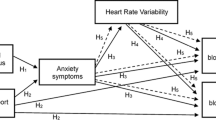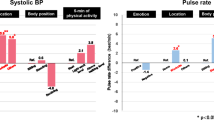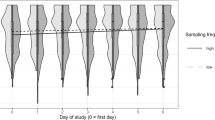Abstract
Identifying momentary influences on ambulatory blood pressure (ABP) will help explain ABP variability; however, most research only examines aggregate ABP at the between-person level. This study used within-person methods to examine whether affective dimensions—valence and arousal—differentially predicted momentary ABP levels. A community sample (n = 39) wore an ABP cuff that took BP measurements every 20 min for 24 h. At each measurement, participants reported levels of valence and arousal on electronic diaries. Multilevel modeling was used to examine the effects of momentary and person-averaged levels of valence and arousal on ABP. Greater momentary negative valence and arousal predicted higher systolic BP compared to more positive or lower arousal assessments; higher averaged levels of arousal predicted higher DBP. The results suggest the independence of the effects of valence and arousal on BP. These findings have important implications for designing interventions to lower ABP.
Similar content being viewed by others
References
Achten, J., & Jeukendrup, A. E. (2003). Heart rate monitoring. Sports Medicine, 33, 517–538.
Appleton, A. A., Buka, S. L., Loucks, E. B., Gilman, S. E., & Kubzansky, L. D. (2013). Divergent associations of adaptive and maladaptive emotion regulation strategies with inflammation. Health Psychology, 32, 748–756.
Arai, Y., Saul, J. P., Albrecht, P., Hartley, L. H., Lilly, L. S., Cohen, R. J., & Colucci, W. S. (1989). Modulation of cardiac autonomic activity during and immediately after exercise. American Journal of Physiology-Heart and Circulatory Physiology, 256, H132–H141.
Blackwell, E., de Leon, C. F. M., & Miller, G. E. (2006). Applying mixed regression models to the analysis of repeated-measures data in psychosomatic medicine. Psychosomatic Medicine, 68, 870–878.
Bliziotis, I. A., Destounis, A., & Stergiou, G. S. (2012). Home versus ambulatory and office blood pressure in predicting target organ damage in hypertension: A systematic review and meta-analysis. Journal of Hypertension, 30, 1289–1299.
Boehm, J. K., & Kubzansky, L. D. (2012). The heart’s content: The association between positive psychological well-being and cardiovascular health. Psychological Bulletin, 138, 655–691.
Bolger, N., & Laurenceau, J. P. (2013). Intensive longitudinal methods: An introduction to diary and experience sampling research. New York: The Guilford Press.
Brondolo, E., Rieppi, R., Erickson, S. A., Bagiella, E., Shapiro, P. A., McKinley, P., & Sloan, R. P. (2003). Hostility, interpersonal interactions, and ambulatory blood pressure. Psychosomatic Medicine, 65, 1003–1011.
Brosschot, J. F., & Thayer, J. F. (2003). Heart rate response is longer after negative emotions than after positive emotions. International Journal of Psychophysiology, 50, 181–187.
Cavalcante, P. A. M., Rica, R. L., Evangelista, A. L., Serra, A. J., Figueira, A, Jr, Pontes, F. L, Jr, et al. (2015). Effects of exercise intensity on postexercise hypotension after resistance training session in overweight hypertensive patients. Clinical Interventions in Aging, 10, 1487–1495.
Cohen, S., & Pressman, S. D. (2006). Positive affect and health. Current Directions in Psychological Science, 15, 122–125.
Cornelissen, V. A., & Smart, N. A. (2013). Exercise training for blood pressure: A systematic review and meta-analysis. Journal of the American Heart Association, 2, 1–9.
Edmondson, D., Arndt, J., Alcántara, C., Chaplin, W., & Schwartz, J. E. (2015). Self-esteem and the acute effect of anxiety on ambulatory blood pressure. Psychosomatic Medicine, 77, 833–841.
Fagard, R. H., Celis, H., Thijs, L., Staessen, J. A., Clement, D. L., De Buyzere, M. L., & De Bacquer, D. A. (2008). Daytime and nighttime blood pressure as predictors of death and cause-specific cardiovascular events in hypertension. Hypertension, 51, 55–61.
Fletcher, G. F., Balady, G., Blair, S. N., Blumenthal, J., Caspersen, C., Chaitman, B., et al. (1996). Statement on exercise: Benefits and recommendations for physical activity programs for all Americans a statement for health professionals by the committee on exercise and cardiac rehabilitation of the council on clinical cardiology, American Heart Association. Circulation, 94, 857–862.
Gerin, W., Davidson, K. W., Christenfeld, N. J., Goyal, T., & Schwartz, J. E. (2006). The role of angry rumination and distraction in blood pressure recovery from emotional arousal. Psychosomatic Medicine, 68, 64–72.
Hermida, R. C., Smolensky, M. H., Ayala, D. E., Portaluppi, F., Crespo, J. J., Fabbian, F., et al. (2013). 2013 Ambulatory blood pressure monitoring recommendations for the diagnosis of adult hypertension, assessment of cardiovascular and other hypertension-associated risk, and attainment of therapeutic goals: Joint recommendations from the International Society for Chronobiology (ISC), American Association of Medical Chronobiology and Chronotherapeutics (AAMCC), Spanish Society of Applied Chronobiology, Chronotherapy, and Vascular Risk (SECAC), Spanish Society of Atherosclerosis (SEA), and Romanian Society of Internal Medicine (RSIM). Chronobiology International, 30, 355–410.
Heron, K. E., & Smyth, J. M. (2010). Ecological momentary interventions: Incorporating mobile technology into psychosocial and health behaviour treatments. British Journal of Health Psychology, 15, 1–39.
Hicken, M. T., Lee, H., Morenoff, J., House, J. S., & Williams, D. R. (2014). Racial/ethnic disparities in hypertension prevalence: Reconsidering the role of chronic stress. American Journal of Public Health, 104, 117–123.
Jacob, R. G., Thayer, J. F., Manuck, S. B., Muldoon, M. F., Tamres, L. K., Williams, D. M., et al. (1999). Ambulatory blood pressure responses and the circumplex model of mood: A 4-day study. Psychosomatic Medicine, 61, 319–333.
Jain, S., Shapiro, S. L., Swanick, S., Roesch, S. C., Mills, P. J., Bell, I., & Schwartz, G. E. (2007). A randomized controlled trial of mindfulness meditation versus relaxation training: Effects on distress, positive states of mind, rumination, and distraction. Annals of Behavioral Medicine, 33, 11–21.
James, G. D., Yee, L. S., Harshfield, G. A., Blank, S. G., & Pickering, T. G. (1986). The influence of happiness, anger, and anxiety on the blood pressure of borderline hypertensives. Psychosomatic Medicine, 48, 502–508.
Jonas, B. F., & Lando, J. F. (2000). Negative affect as a prospective risk factor for hypertension. Psychosomatic Medicine, 62, 188–196.
Kamarck, T. W., Janicki, D. L., Shiffman, S., Polk, D. E., Muldoon, M. F., Liebenauer, L. L., & Schwartz, J. E. (2002). Psychosocial demands and ambulatory blood pressure: A field assessment approach. Physiology & Behavior, 77, 699–704.
Katzmarzyk, P. T. (2010). Physical activity, sedentary behavior, and health: Paradigm paralysis or paradigm shift? Diabetes, 59, 2717–2725.
Kaushik, R. M., Kaushik, R., Mahajan, S. K., & Rajesh, V. (2006). Effects of mental relaxation and slow breathing in essential hypertension. Complementary Therapies in Medicine, 14, 120–126.
Kikuya, M., Ohkubo, T., Asayama, K., Metoki, H., Obara, T., Saito, S., et al. (2005). Ambulatory blood pressure and 10-year risk of cardiovascular and noncardiovascular mortality: The Ohasama study. Hypertension, 45, 240–245.
Knight, W. E., & Rickard, N. S. (2001). Relaxing music prevents stress-induced increases in subjective anxiety, systolic blood pressure, and heart rate in healthy males and females. Journal of Music Therapy, 38, 254–272.
Kramer, G. H. (1983). The ecological fallacy revisited: Aggregate-versus individual-level findings on economics and elections, and sociotropic voting. American Political Science Review, 77, 92–111.
Lazarus, R. S. (1991). Emotions and adaptation. New York: Oxford University Press.
McHorney, C. A., Ware, J. E, Jr, & Raczek, A. E. (1993). The MOS 36-Item Short-Form Health Survey (SF-36): II. Psychometric and clinical tests of validity in measuring physical and mental health constructs. Medical Care, 31, 247–263.
Molenaar, P. C., & Campbell, C. G. (2009). The new person-specific paradigm in psychology. Current Directions in Psychological Science, 18, 112–117.
Moons, W. G., Eisenberger, N. I., & Taylor, S. E. (2010). Anger and fear responses to stress have different biological profiles. Brain, Behavior, and Immunity, 24, 215–219.
Muthén, L. K., & Muthén, B. O. (1998-2011). Mplus user’s guide, 6th edn. Los Angeles, CA: Muthén & Muthén.
Myers, N. D., Brincks, A. M., Ames, A. J., Prado, G. J., Penedo, F. J., & Benedict, C. (2012). Multilevel modeling in psychosomatic medicine research. Psychosomatic Medicine, 74, 925–936.
Neumann, S. A., & Waldstein, S. R. (2001). Similar patterns of cardiovascular response during emotional activation as a function of affective valence and arousal and gender. Journal of Psychosomatic Research, 50, 245–253.
Nwankwo, T., Yoon, S. S., Burt, V., & Gu, Q. (2013). Hypertension among adults in the United States: National Health and Nutrition Examination Survey, 2011–2012. NCHS Data Brief, 133, 1–8.
O’Brien, E., Pickering, T., Asmar, R., Myers, M., Parati, G., Staessen, J., et al. (2002). Working Group on Blood Pressure Monitoring of the European Society of Hypertension International Protocol for validation of blood pressure measuring devices in adults. Blood Pressure Monitoring, 7, 3–17.
Ottaviani, C., Shapiro, D., & Fitzgerald, L. (2011). Rumination in the laboratory: What happens when you go back to everyday life? Psychophysiology, 48, 453–461.
Palatini, P. (2008). Ambulatory blood pressure and cardiovascular risk in chronic kidney disease. Current Hypertension Reports, 10, 119–126.
Portnov, B. A., Dubnov, J., & Barchana, M. (2007). On ecological fallacy, assessment errors stemming from misguided variable selection, and the effect of aggregation on the outcome of epidemiological study. Journal of Exposure Science & Environmental Epidemiology, 17, 106–121.
Räikkönen, K., Matthews, K. A., Flory, J. D., Owens, J. F., & Gump, B. B. (1999). Effects of optimism, pessimism, and trait anxiety on ambulatory blood pressure and mood during everyday life. Journal of Personality and Social Psychology, 76, 104–113.
Russell, J. A. (1980). A circumplex model of affect. Journal of Personality and Social Psychology, 39, 1161–1178.
Russell, J. A., & Carroll, J. M. (1999). On the bipolarity of positive and negative affect. Psychological Bulletin, 125, 3–30.
Samuels, J., Ng, D., Flynn, J. T., Mitsnefes, M., Poffenbarger, T., Warady, B. A., & Furth, S. (2012). Ambulatory blood pressure patterns in children with chronic kidney disease. Hypertension, 60, 43–50.
Schum, J. L., Jorgensen, R. S., Verhaeghen, P., Sauro, M., & Thibodeau, R. (2003). Trait anger, anger expression, and ambulatory blood pressure: A meta-analytic review. Journal of Behavioral Medicine, 26, 395–415.
Schwartz, J. E., & Stone, A. A. (1998). Strategies for analyzing ecological momentary assessment data. Health Psychology, 17, 6–16.
Shapiro, D., Jamner, L. D., & Goldstein, I. B. (1997). Daily mood states and ambulatory blood pressure. Psychophysiology, 34, 399–405.
Singer, J. D., & Willett, J. B. (2003). Applied longitudinal data analysis: Modeling change and event occurrence. New York: Oxford University Press.
Smith, T. W., Birmingham, W., & Uchino, B. N. (2012). Evaluative threat and ambulatory blood pressure: Cardiovascular effects of social stress in daily experience. Health Psychology, 31, 763–766.
Smyth, J. M., & Stone, A. A. (2003). Ecological momentary assessment research in behavioral medicine. Journal of Happiness Studies, 4, 35–52.
Suls, J., Wan, C. K., & Costa, P. T. (1995). Relationship of trait anger to resting blood pressure: A meta-analysis. Health Psychology, 14, 444–456.
Verdecchia, P. (2000). Prognostic value of ambulatory blood pressure current evidence and clinical implications. Hypertension, 35, 844–851.
Warner, R. M., & Strowman, S. R. (1995). Cardiovascular reactivity and positive/negative affect during conversations. Journal of Behavioral Medicine, 18, 141–159.
Watson, D. (1988). Intraindividual and interindividual analyses of positive and negative affect: Their relation to health complaints, perceived stress, and daily activities. Journal of Personality and Social Psychology, 54, 1020–1030.
Watson, D., Clark, L. A., & Tellegen, A. (1988). Development and validation of brief measures of positive and negative affect: The PANAS scales. Journal of Personality and Social Psychology, 54, 1063–1070.
Watson, D., & Pennebaker, J. W. (1989). Health complaints, stress, and distress: Exploring the central role of negative affectivity. Psychological Review, 96, 234–254.
Watson, D., & Tellegen, A. (1985). Toward a consensual structure of mood. Psychological Bulletin, 98, 219–235.
Zawadzki, M. J., Vandekar, L., Smyth, J. M., Haas, D., & Gerin, W. (2013). An extended validation of the ScottCare 320 ambulatory blood pressure monitor: Recommendations for clinical application. Blood Pressure Monitoring, 18, 151–155.
Funding
This work was funded in part by ScottCare Cardiovascular Solutions, Cleveland, OH
Author information
Authors and Affiliations
Corresponding author
Ethics declarations
Conflict of interest
Matthew J. Zawadzki, Jennifer Mendiola, Eric A. Walle and William Gerin declare that they have no conflict of interest
Human and animal rights and Informed consent
All procedures followed were in accordance with ethical standards of the responsible committee on human experimentation (institutional and national) and with the Helsinki Declaration of 1975, as revised in 2000. Informed consent was obtained from all patients for being included in the study.
Rights and permissions
About this article
Cite this article
Zawadzki, M.J., Mendiola, J., Walle, E.A. et al. Between-person and within-person approaches to the prediction of ambulatory blood pressure: the role of affective valence and intensity. J Behav Med 39, 757–766 (2016). https://doi.org/10.1007/s10865-016-9746-6
Received:
Accepted:
Published:
Issue Date:
DOI: https://doi.org/10.1007/s10865-016-9746-6




